Jasper Lake Fanless Showdown: ECS LIVA Z3 and ZOTAC ZBOX CI331 nano UCFF PCs Review
by Ganesh T S on July 8, 2022 8:30 AM EST- Posted in
- Systems
- ZOTAC
- Fanless
- ECS
- Passive Cooling
- UCFF
- Mini-PC
- Jasper Lake
HTPC Credentials
The HTPC-related sections in previous SFF PC reviews covered a range of aspects. Display refresh rate stability (particularly, the ability to drive 23.976 Hz for stutter-free playback of cinema content), OTT streaming efficiency (YouTube and Netflix), and local media playback performance and efficiency evaluation were some of them. While such a detailed study may still make sense for dedicated HTPC reviews, we have decided to pare down the evaluated aspects for system reviews. Workloads were processed on the ECS JSLM-MINI and the ZOTAC ZBOX CI331 nano for the results in this section.
YouTube Streaming Efficiency
4K video streaming has become ubiquitous enough for its support to be a necessity even for secondary HTPCs. HDR has also become affordable. Keeping these aspects in mind, we have chosen Mystery Box's Peru 8K HDR 60FPS video as our test sample moving forward. On PCs running Windows, it is recommended that HDR streaming videos be viewed using the Microsoft Edge browser after putting the desktop in HDR mode.

YouTube Streaming - ECS JSLM-MINI

YouTube Streaming - ZOTAC ZBOX CI331 nano
Intel's UHD Graphics for Gen 11 supports hardware decoding for VP9 Profile 2. Taking advantage of this feature, MS Edge automatically fetches the 4Kp60 VP9 Profile 2 encode from the YouTube servers. However, the playback was punctuated by frequent dropped frames on both systems as shown in the statistics segment of the above screenshots.
Various metrics of interest such as GPU usage and at-wall power consumption were recorded for the first four minutes of the playback of the above video. The numbers are graphed below.
The reason for the dropped frames is evident by the spikes in D3D Usage. However, as we shall see further down in this section, this problem doesn't manifest itself in local playback. The culprit here seems to be the MS Edge browser itself, rather than the hardware platform.
Hardware-Accelerated Encoding and Decoding
The transcoding benchmarks in the systems performance section presented results from evaluating the QuickSync encoder within Handbrake's framework. The iGPU in the systems support hardware encode for AVC, JPEG, HEVC (8b and 10b, 4:2:0 and 4:4:4), and VP9 (8b and 10b, 4:2:0 and 4:4:4). The capabilities of the decoder engine are brought out by DXVAChecker. They were the same for both the ECS JSLM-MINI and the ZOTAC ZBOX CI331 nano.
The decoder engine in Jasper Lake is not the latest and greatest that Intel has to offer. For example, HEVC and VP9 12b support, as well as AV1 support are absent. AV1 is quite new, and the others are required only for professional applications - market segments that are not targeted by Jasper Lake systems.
Local Media Playback
Evaluation of local media playback and video processing is done by playing back files encompassing a range of relevant codecs, containers, resolutions, and frame rates. A note of the efficiency is also made by tracking GPU usage and power consumption of the system at the wall. Users have their own preference for the playback software / decoder / renderer, and our aim is to have numbers representative of commonly encountered scenarios. Considering the target market for Jasper Lake systems, we played back the test streams using the following install-and-forget combinations:
- VLC 3.17.4
- Kodi 19.4
The fourteen test streams (each of 90s duration) were played back from the local disk with an interval of 30 seconds in-between. Various metrics including GPU usage and at-wall power consumption were recorded during the course of this playback. Based on the DXVAChecker report presented previously, the GPU should be able to play back all codecs with hardware acceleration (except for AV1).
All our playback tests were done with the desktop HDR setting turned on. It is possible for certain system configurations to automatically turn on/off the HDR capabilities prior to the playback of a HDR video, but, we didn't take advantage of that in our testing.
VLC and Kodi
VLC is the playback software of choice for the average PC user who doesn't need a ten-foot UI. Its install-and-play simplicity has made it extremely popular. Over the years, the software has gained the ability to take advantage of various hardware acceleration options. Kodi, on the other hand, has a ten-foot UI making it the perfect open-source software for dedicated HTPCs. Support for add-ons make it very extensible and capable of customization. We played back our test files using the default VLC and Kodi configurations, and recorded the following metrics.
| ECS JSLM-MINI Video Playback Efficiency - VLC and Kodi | |||
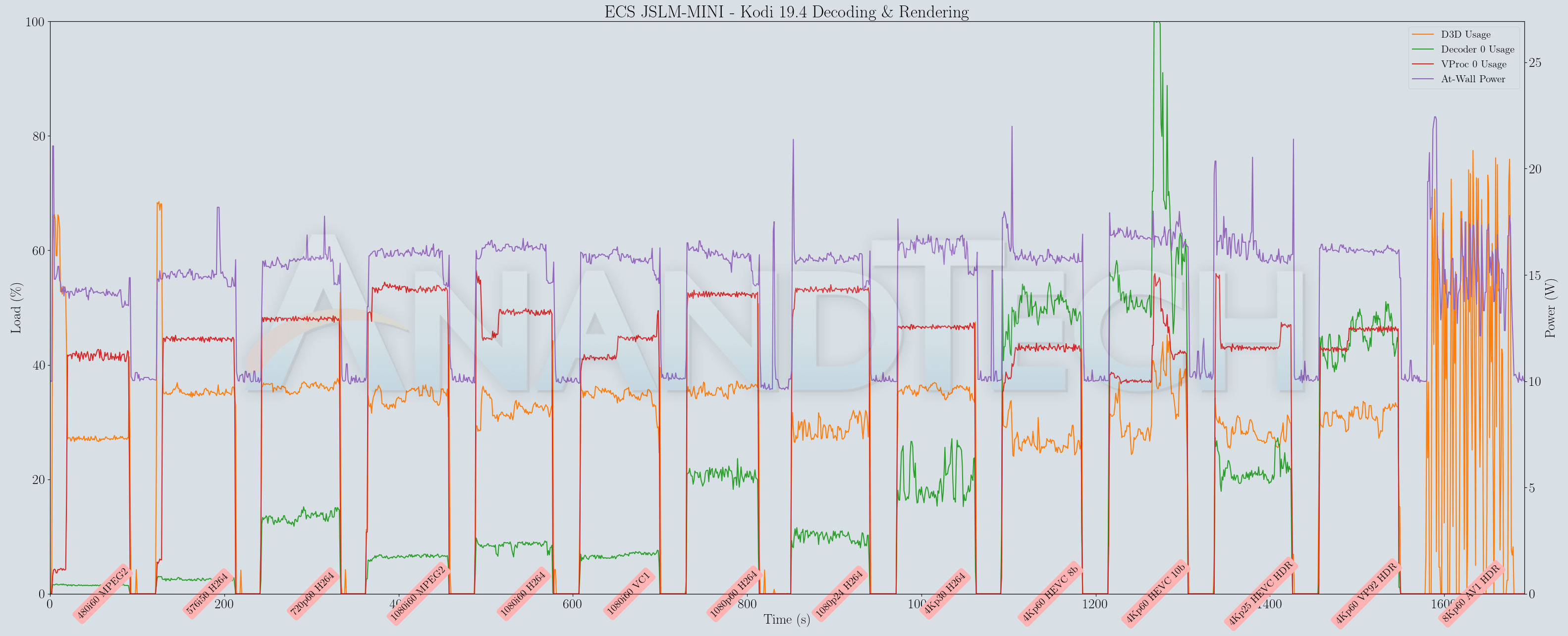
| ZOTAC ZBOX CI331 nano Video Playback Efficiency - VLC and Kodi | |||
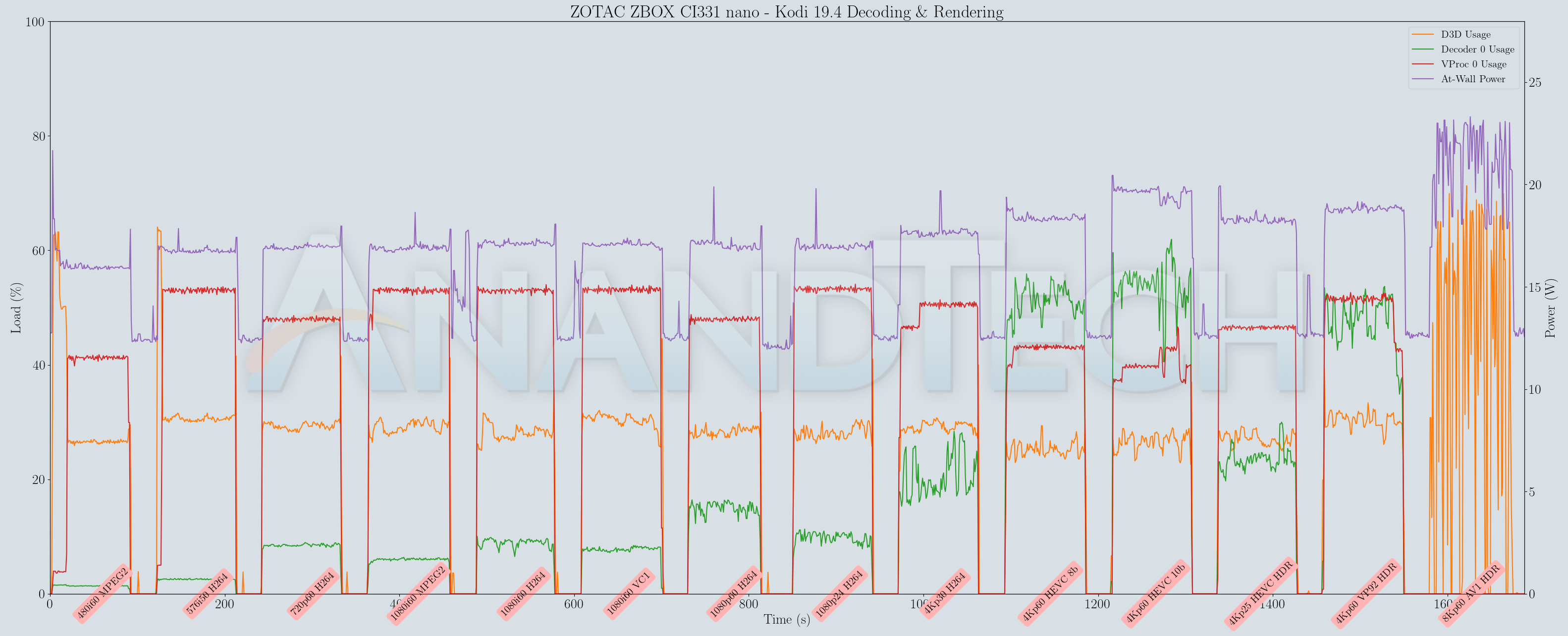
Both players in both systems had great trouble handling the 8Kp60 AV1 clip, due to the absence of hardware acceleration. In addition to consuming lots of power, the playback was just a sequence of frames updated every few seconds. Other than that, all other codecs played without missing a frame, with hardware acceleration activated for low-power playback.
Overall, both systems can be recommended for media playback from the local disk or over the local network. Using web browsers is a hit or miss depending on the codec, resolution, and browser. The presence of hardware acceleration also ensures that the systems are unlikely to get thermally limited during playback.


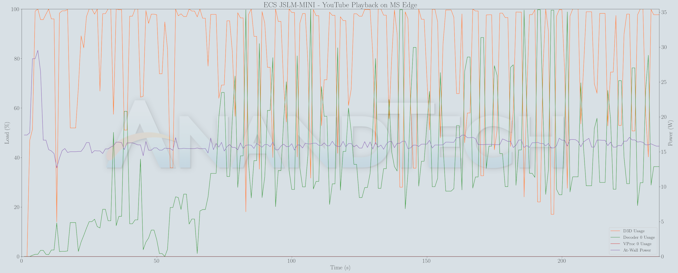
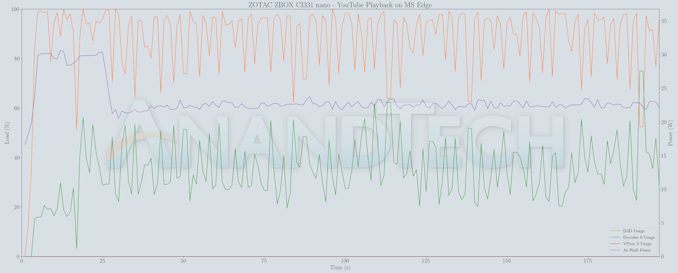
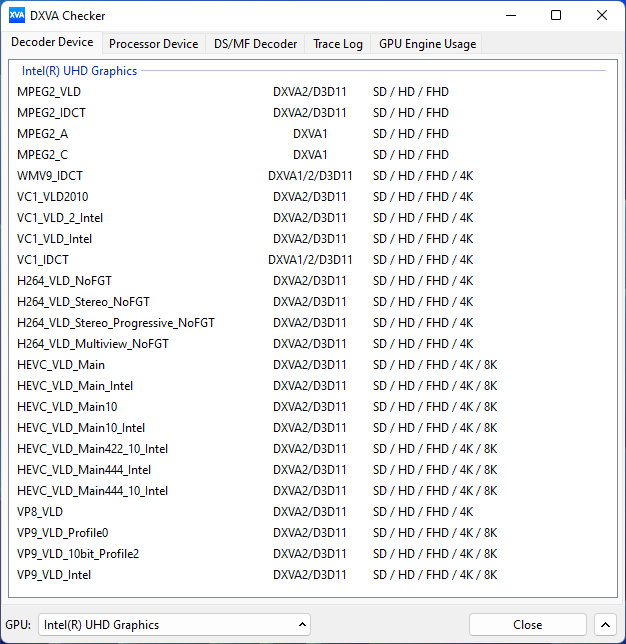








52 Comments
View All Comments
mode_13h - Tuesday, July 19, 2022 - link
BTW, I'm seeing Supermicro (DDR5) W680 boards now in stock! Unfortunately, I can't say the same for DDR5-4800 Unbuffered ECC DIMMs. It's good that I'm in no hurry.Oxford Guy - Tuesday, July 12, 2022 - link
'After suspecting thermal throttling due to the lack of convective cooling for the thermal module, we decided to repeat all the benchmarking for the bare board - i.e, with the top of the chassis removed and the DMICs / WLAN functionality discarded.'What is this nonsense?
You test the product the way it is designed and sold. If it's designed by idiots it deserves the review it gets.
Oxford Guy - Tuesday, July 12, 2022 - link
ECS knows what ventilation slots are. The first model of Liva has them on the top, bottom, and sides of the unit!ganeshts - Tuesday, July 12, 2022 - link
That is pretty much what I wanted to do, but I ran the numbers just to prove to ECS that it is their chassis that is the problem, and not the internal thermal module. (Typically, we have a back-and-forth with the vendor in case things aren't performing as expected, just to make sure they can reproduce the issue on their side too).So, once I had the results, I decided to just include it in the review to show readers that the problems lie with the case.
mode_13h - Wednesday, July 13, 2022 - link
> I ran the numbers just to prove to ECS that it is their chassis that is the problemAnd thank you for doing it. Testing as-sold is fine, and those numbers should be the main ones reported. However, supplemental testing to investigate suspected design flaws is the mark of a quality reviewer.
Keep up the good work!
Oxford Guy - Saturday, July 16, 2022 - link
Zen 1 and 2, tested with JEDEC slowwww RAM and not also with any XMP profiles.LIVA Z3 tested without its case and one of its main parts.
I guess removing the protective case and the wireless Internet of a computer is more normal ordinary user behavior than turning on XMP in BIOS.
Just trying to understand the big picture here...
Oxford Guy - Saturday, July 16, 2022 - link
And, of course, that continues:‘As a result, in lieu of CPU overclocking, the biggest thing a user can do to influence higher performance with the Ryzen 7 5800X3D is to use faster DDR4 memory with lower latencies, such as a good DDR4-3600 kit. These settings are also the known sweet spot for AMD's Infinity Fabric Interconnect as set out by AMD.’
proceeds to test with 3200-speed RAM...
mode_13h - Sunday, July 17, 2022 - link
> LIVA Z3 tested without its case and one of its main parts.Yes, but only supplementing their testing in its baseline "as-sold" config. You really ought to go back and re-read stuff before rage-posting about it.
"The numbers for this configuration are referenced using ECS JSLM-MINI (the motherboard's model name) in the relevant sections."
Where data from this configuration is posted, you'll see *both* ECS LIVA Z3 *and* ECS JSLM-MINI, showing just how much the Z3 is hurt by the poor airflow of its chassis.
Oxford Guy - Sunday, July 17, 2022 - link
'You really ought to go back and re-read stuff before rage-posting about it.'Your usual ad hom routine won't change this interesting inconsistency.
mode_13h - Sunday, July 17, 2022 - link
> Your usual ad hom routineNo, you're flat-out wrong. Trying to shift the subject back on me won't change that. I'd almost feel bad for you embarrassing yourself like this, but you never seem to tire of reminding us what an unpleasant person you are.
FYI: the correct response, when you've been caught leveling a false allegation is: "Oops. Sorry." Anything else just makes it worse.